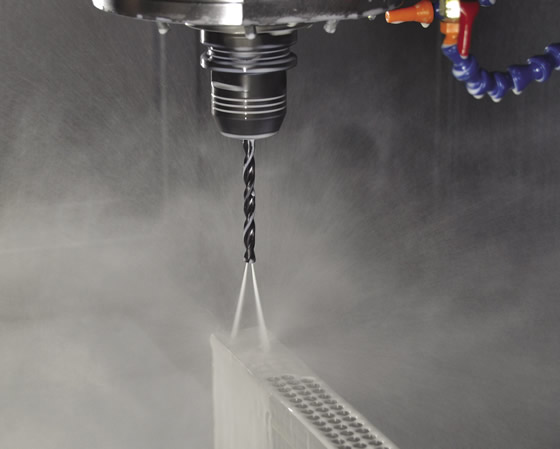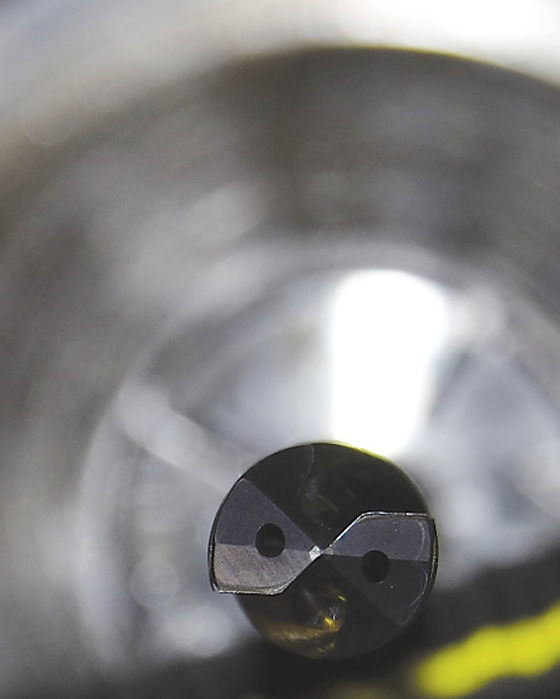Dormer Pramet’s continuously thinned web (CTW) technology is unique to the company’s rotary drilling range. Traditionally, web thinning is performed as an additional operation after point grinding, according to the company. A drill point is thinned by shortening the length of the chisel edge to reduce the needed thrust force. CTW technology simplifies the chisel thinning process as the depth is already set, and, therefore, no adjustments are needed during regrind, regardless of drill length.
“CTW increases both flute volume and cross sectional strength,” said Ricky Payling, application specialist at Dormer Pramet. “The combination of these elements ensures consistent forces throughout the drilling cycle, with little or no increase in power requirement as the drill penetrates deeper into the hole. This, in turn, allows increased cutting speeds and greater performance reliability without compromising tool life.”

Dormer Pramet’s R459 solid-carbide drill is for producing holes up to 8 diameters deep. Image courtesy Dormer Pramet.

The point design of the R459 drill after machining stainless steel for 30 minutes. Image courtesy Dormer Pramet.
Payling noted tool symmetry is retained after regrinding because an amount of web thinning is built into the design. This means the drill will not degenerate over time and will maintain its torque strength.
Dormer Pramet provides CTW in its new R459 drill for producing holes up to 8 diameters deep. However, the toolmaker hopes to expand its use to other drills in the near future.
In-house tests show how well the R459 drill cuts aluminum, hardened steel and stainless steel. For example, after drilling 316-L stainless steel at a cutting speed of 35 m/min. (114.8 sfm), a spindle speed of 1,395 rpm and a feed rate of 0.1 mm/rev. (0.004 ipr), or 140 mm/min. (5.51 ipm), for 30 minutes, the cutting edges showed a small amount of pick up with an even wear scar running across them.
After machining aluminum for 30 minutes at a cutting speed of 285 m/min. (935 sfm), a spindle speed of 11,340 rpm and a feed of 0.26 mm/rev. (0.010 ipr), or 2,950 mm/min. (116.1 ipm), the R459 drill showed minimal edge wear, with a small amount of pick up.
For more information about Dormer Pramet, Elgin, Ill., call (847) 783-5700, email cs@dormer pramet.com or visit www.dormer pramet.com. CTE
About the Author: Matt Jaster is senior editor of CTE. Contact him at (847) 714-0174 or [email protected].
Related Glossary Terms
- cutting speed
cutting speed
Tangential velocity on the surface of the tool or workpiece at the cutting interface. The formula for cutting speed (sfm) is tool diameter 5 0.26 5 spindle speed (rpm). The formula for feed per tooth (fpt) is table feed (ipm)/number of flutes/spindle speed (rpm). The formula for spindle speed (rpm) is cutting speed (sfm) 5 3.82/tool diameter. The formula for table feed (ipm) is feed per tooth (ftp) 5 number of tool flutes 5 spindle speed (rpm).
- feed
feed
Rate of change of position of the tool as a whole, relative to the workpiece while cutting.
- grinding
grinding
Machining operation in which material is removed from the workpiece by a powered abrasive wheel, stone, belt, paste, sheet, compound, slurry, etc. Takes various forms: surface grinding (creates flat and/or squared surfaces); cylindrical grinding (for external cylindrical and tapered shapes, fillets, undercuts, etc.); centerless grinding; chamfering; thread and form grinding; tool and cutter grinding; offhand grinding; lapping and polishing (grinding with extremely fine grits to create ultrasmooth surfaces); honing; and disc grinding.
- web
web
On a rotating tool, the portion of the tool body that joins the lands. Web is thicker at the shank end, relative to the point end, providing maximum torsional strength.

